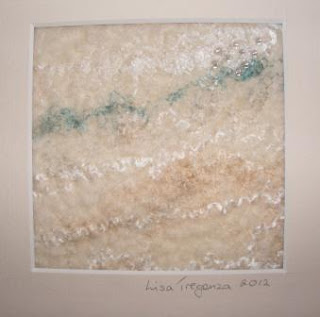Many thanks to Elen Phillips and Sioned Williams, curators at St Fagan's (National History Museum of Wales), for a fascinating and very productive research visit today. I am doing some preparatory work on a piece (which will probably evolve into a collection) of work based on some vintage French linen I have acquired, seeking to tell the hidden story of generations of anonymous women whose only footprint on history is the stitches - embroidery, mending - they have left behind in the textiles they worked on. I am looking to use authentic motifs and techniques in this work, and St Fagan's is definitely the place to go to research this.
The collection is enormous - Elen had selected 6 large archive boxes of samplers, dating from the late 18th to the early 20th centuries, for me to look at, while Sioned brought along a range of domestic linen (including mattress covers, sheets, handkerchief cases and tray cloths), mostly 19th century, from all over Wales. Some of the domestic linen even had letters enclosed in the folds of the fabric, written by the donor and giving the history of the item. A beautiful silk jacquard hand towel (apparently unused) was part of a trousseau given to a 19th century bride in Machynlleth by her father.
I found the experience very moving - many of the samplers were made by very young girls - Mary Ann Baker aged 7 years (19th century), Mary Lewis aged 9 years (1797), Sarah Brigg aged 9 years (18th century), Ruth Davies aged 13 (1855). Some of the samplers in the collection are unfinished, and one in particular pulled me up short: Accession number 41.86/6
Unfinished sampler 19th century. This one has a trailing thread from the last stitch - why was it never finished? What happened to the maker? In a time of high juvenile mortality, did she die before she could finish her sampler? The name of the maker is usually in the lower part of the sampler, and she stopped two-thirds of the way down, so we do not even know her name. I think something from this sampler will have to find its way into my work.
My particular favourites were a blackwork sampler (unfinished) from c1800, and one worked in red threads on linen, also unfinished (this seems to be becoming a theme!) from some time in the 19th century - the motif of oak leaves and acorns centre right is very reminiscent of the National Trust logo!
I'm very grateful to Elen and Sioned for making my visit possible, and I shall definitely be back to do more research in this wonderful collection. I don't think the availability of this fantastic research resource is widely enough known - I know I have only seen the tip of the iceberg, but I was overwhelmed both by the richness of the collection, and the helpfulness of the curators.
 |
| Blackwork sampler c1800 |
 |
| Blackwork sampler c1800 detail |
 |
| Red on linen, unfinished, 19th century |
 |
| Unfinished sampler 19th century - trailing thread |
 |
| Eliza M D Griffies W...ms 1819 |
 |
| Eliza M D Griffies W...ms 1819 detail |
 |
| Jane Walker 1822 |











.jpg)
.jpg)
.jpg)
.jpg)